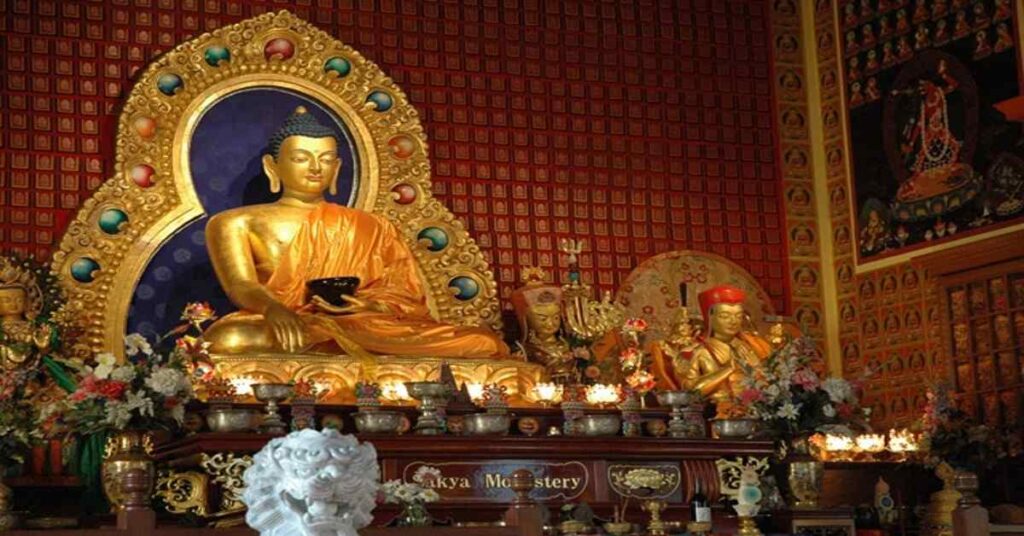Introduction of the Buddhism Era in India


In the 6th century, Buddhism was promoted by Buddha. Buddhism is a majority religion in most Asian countries.
Buddhism had taken numerous varieties, except in this instance, the Buddha’s life circumstances, lessons, as well as the “spirit” or “essence” of his teachings (known as dhamma or dharma) have all been used as examples of religious life.
We don’t know a complete narrative of the Buddha’s life until Ashvaghosa wrote the Buddha Charita (History of the Buddha) in the 1st or 2nd century C.E. Buddhist was Born and brought up at Lumbini, amid the Himalayan foothills, around 563 B.C.E., and started around Benares (at Sarnath).
The early life of Buddhism in India
His age was marked by spiritual, intellectual, as well as social upheaval. The Upanishads were composed during this period, and the Hindu concept of sacrifice of family and sociopolitical by saintly individuals seeking Truth initially became popular. Both can be understood as movements apart from the Vedic fire sacrifice’s importance.
Siddhartha Gautama was the son of a royal couple who was a warrior. His father lavished him with luxury and joy to keep this from happening. However, go on a sequence of four chariot drives as a young man, during which he witnessed the more extreme types of human suffering:
An austere renouncer, as well as old age, disease, and death (a corpse). The difference between his presence and this human suffering showed him that almost all of life’s pleasures are ephemeral and can only function to distract from human suffering. He recruited the assistance of numerous instructors and attempted a severe renunciation in the wilderness until he was nearly starving, abandoning his family and a young son named “Rahula” in jail.
Finally, he ate breakfast and settled down under a tree to meditate, recognizing that this was merely adding to his agony. He had gained Nirvana by dawn (or six months later, according to others! ), which brought both the genuine answers to the reasons of sorrow and everlasting escape from it.
Check out our latest article about The Alaska Highway: A Subarctic Road To Prevent Invasion
Buddha’s preachings
Out of compassion for the people’s suffering, the Buddha proceeded to teach those truths to others. The Four Noble Facts and the Eight-Fold Way were among the most fundamental concepts he taught. He preaches the first Noble Truth: life is tough (dukkha). The joys and sorrows of the physical and mental remain abundant in life as we know it; yet, benefits, he claims, do not constitute genuine happiness.
They are inextricably linked to sorrow because we suffer from a want for them, a desire for them to endure, and a desire for grief to end so that pleasure might come. The Second Noble reality is that thirst sensory delights and for objects to be as they are not—causes suffering. We will not tolerate life as its reality.
The third Noble Truth, on the other hand, asserts that hardship got a conclusion, and followed by the next Eight-Fold as well as the Intermediate ways fetches methods to that goal. Nirvana, an incomprehensible state of all-knowing clear consciousness where there is only serenity and joy, can be attained by following this integrated path.
Correct Views (the Four Noble Truths), Right to Intention, Speech, Action, Livelihood/Occupation, Endeavor, as well as Mindfulness (total concentration inactivity), and Mindfulness are all part of the Eight-Fold Path, which is often depicted as an eight-spoked roller (meditation). The concept of the intermediate Way, which describes the Buddha’s life, pervades the Eight-Fold Pathway. The denial of all sides of thinking, feeling, behavior, and culture is symbolized by the Middle Way.
Check out our latest article about Cochin International Airport – A Sustainable Flight Path Cochin-Eco Friendly Airport
Development of social serenity
The Buddha preferred a unique and balanced” traveling career as well as the development of cognitive and social serenity via meditation and ethics, rather than either harsh bodily mortification or a life of indulging in sensual pleasures. Following the Buddha’s demise, his bachelor traveling disciples increasingly calmed down a bit into a monastery supported by merit-producing contributions from the married populace.
The monks then delivered a few of the Buddhist traditions to the laypeople. They also visited the Buddha’s hometown and worshipped the bodhi tree (the tree beneath which he attained enlightenment).


People Worshipped Buddha
Buddha statues in the temple and the remnants of his body are kept in numerous stupas or burial graves. Ashoka, a legendary monarch, and his son contributed to the spread of Buddhism across Southern India and then into Sri Lanka (Ceylon) (3rd century B.C.E.).Through the disciplines of Buddha few monastic schools developed.
This is largely because his actual instructions were ambiguous in some aspects; for example, he hesitated to say categorically whether people have such a soul (atta/atman) or not.
Another cause for the development of different schools occurred as the result of the hesitation to choose a successor to succeed him as Sangha head (monastic order).
He advised the monks to follow the principles of Dhamma and to be light from themself. A major split within the Buddhist fold happened in the first-century C.E.distinguishing both the branches of Mahayana and Hinayana.
Check out our latest article about Indian National Highway System Infrastructure World-Class Success Story
Conclusion of the Buddhism in India
Even though Buddhism became nearly extinct in India (around the twelfth century C.E.)—perhaps due to Hinduism’s all-encompassing character, Muslim conquests, or too much emphasis on the monk’s manner of living has over proven its validity and functional spiritual practices in the Asian countries it reached.
Numerous diverse sorts of people have been able to fulfill their religious requirements via many more structures and practices that have arisen inside the Buddhist fold.
